The sand dunes and deserts of Namibia are always changing, and the country’s massive red rocks and mountains rise abruptly from the savannah floor to meet the clouds. It is a place where the Atlantic Ocean’s frothy and harsh surges bow to the might of the Cape of Good Hope’s storms or spray salty sea over the seal-peppered coves of the Skeleton Coast. Obviously, the landscapes and the backcountry are what have propelled this massive chunk of West Africa to the forefront of adventure tourism on the African continent. 15 Top Places to Visit in Namibia.
With the exception of possibly a few wistful national socialists who long for the ‘golden days’ of German domination, the country has been a rare image of political stability since the end of apartheid (which came to these areas as a result of South African hegemony in the 1980s). Come to Namibia with your sandboard polished, your hiking boots oiled, and your preconceptions discarded, and you will return in awe of its magnificent, underappreciated beauty.
Now, let’s go see 15 Top Places to Visit in Namibia:
Etosha National Park
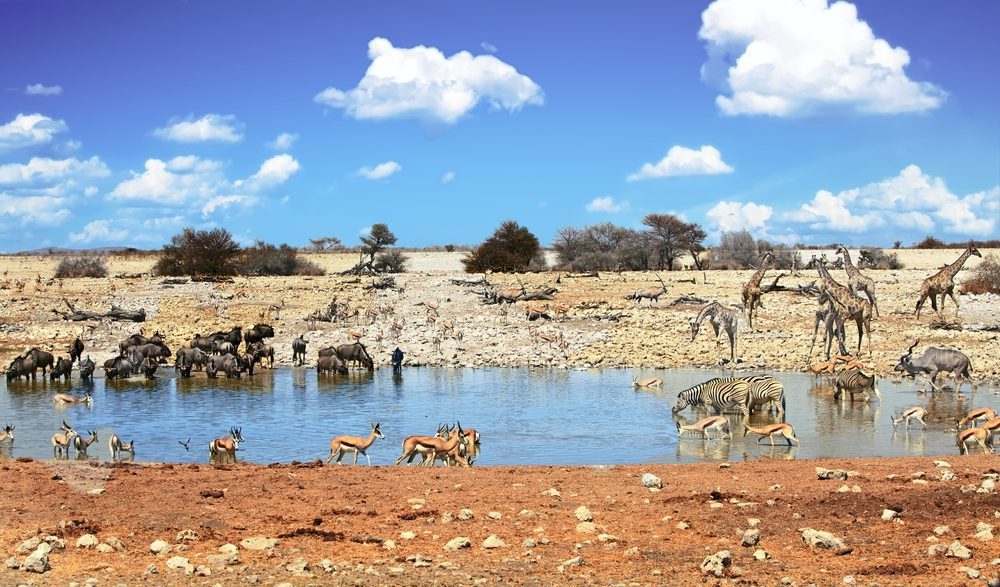
Okaukeujo Waterhole in Etosha National Park. Image source: Paula French/Shutterstock.com
Visit this park if you can only visit one in Namibia.
Since its designation as a game reserve in 1907, Etosha has been lauded for its abundance of unique animal species. The area is now the safari capital of the nation, and it includes the dry, cracked salt pans and the winding valleys of the Leopard Hills, where the famous leopard lurks.
Visit the watering holes to see African bush elephants, plains zebras, the very uncommon black rhino, and the bouncing springbok.
15 Top Places to Visit in Namibia: Sossusvlei
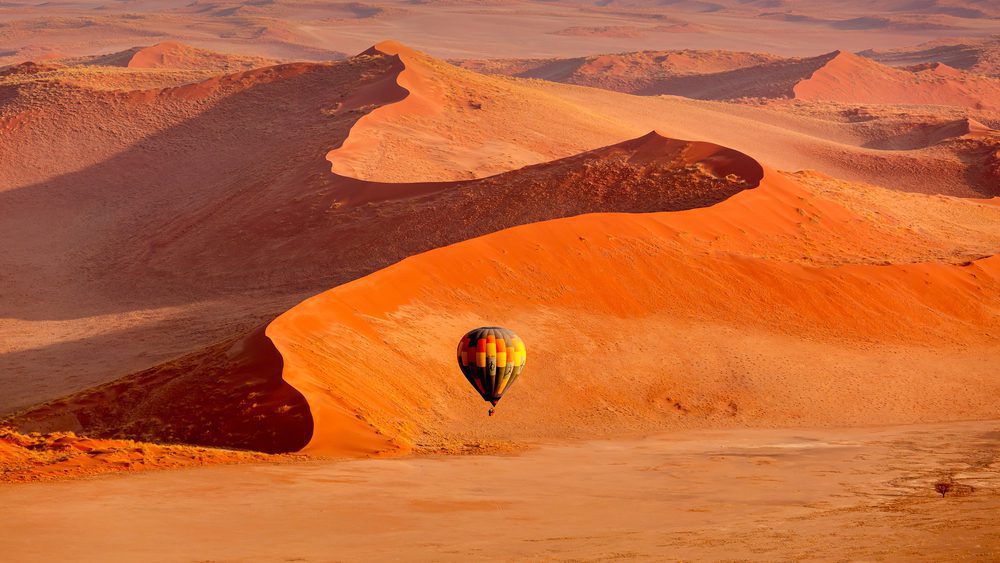
Hot air balloon soaring over Sossusvlei. Image source: Chris de Blank/Shutterstock.com
Destination Namibia is the salt pan of Sossusvlei, located deep inside Namib-Naukluft National Park, where the blazing African sun beats down and sidewinder snakes meander across the undulations of sand.
There are enormous, towering dunes all around us, some of the tallest in the world, and the sight of them is certain to take your breath away.
As the winds blow, these massive sculpted desert areas move, and some portions, like the gigantic mound of Dune 7, reach staggering heights of more than 350 metres above sea level.
The majority of tourists take 4×4 trips, during which they may observe antelope, oryx, springbok, and ostrich, among other animals.
Kaokoland
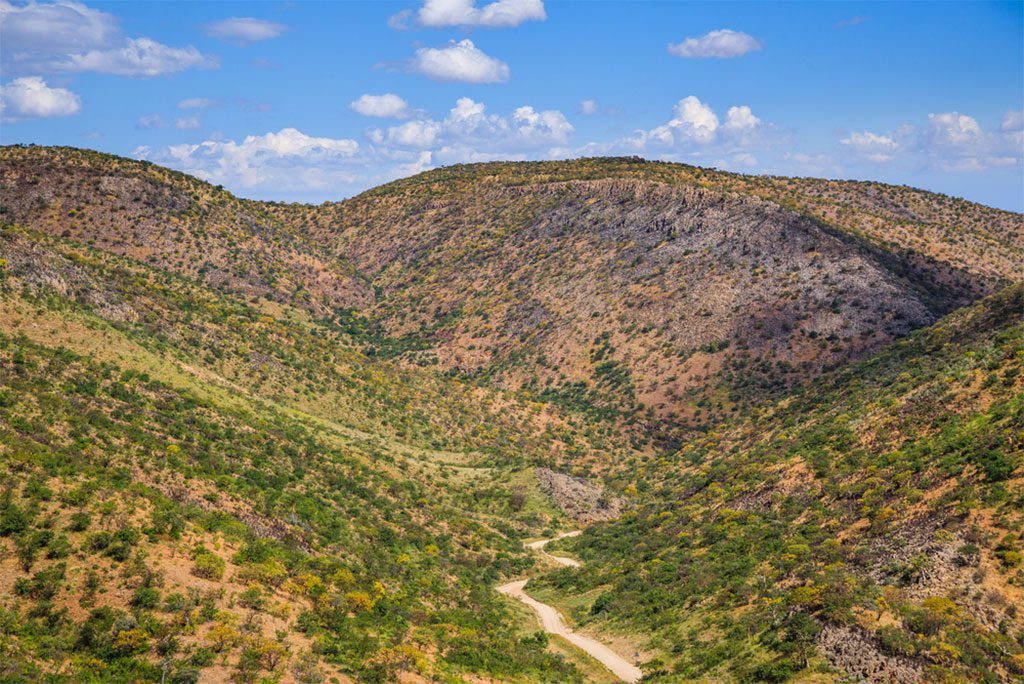
Stunning landscape in the Kaokoland region. Image source: Radek Borovka/Shutterstock.com
The sculpted landscapes of Kaokoland are unparalleled anywhere else in Africa.
The area is lonely and undeveloped, and it is divided by meandering rivers that snake through the rock-ribbed mountains and the vast escarpments of the north, which are reminiscent of the Grand Canyon.
However, it is gradually opening up to visitors, who are flocking there after seeing Etosha National Park.
In particular, they want to meet the friendly Himba people, who have lived as nomads in this region for years and whose smiles never fade.
The interesting mountain elephant, which has adapted to a dry environment and can only be found in Kaokoland, also calls this region home.
Swakopmund
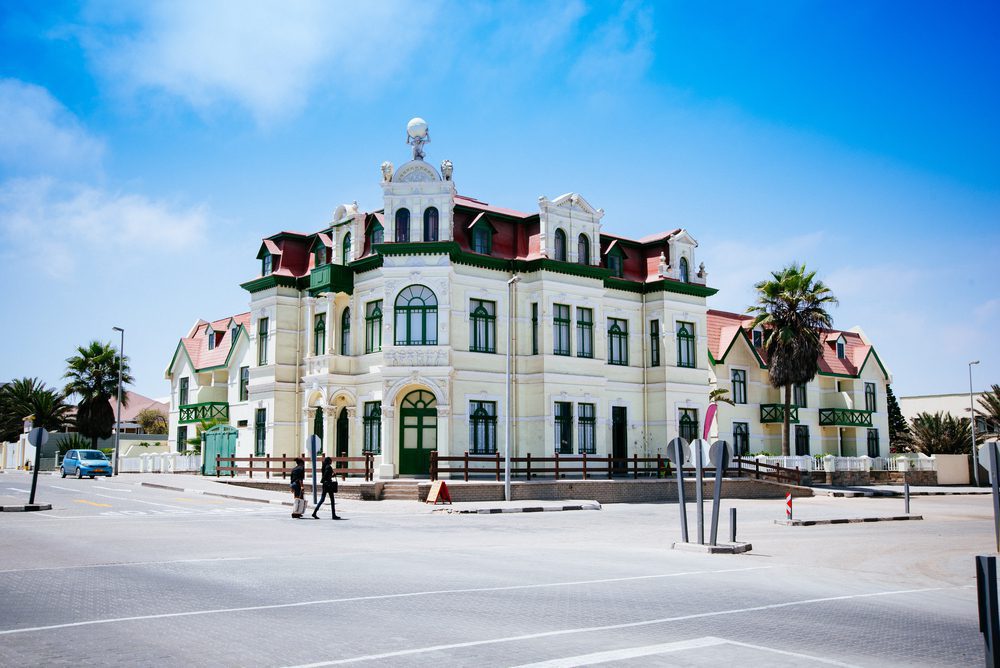
Colonial building Hohenzollernhaus in Swakopmund. Image source: Fotografie-Kuhlmann/Shutterstock.com
It is easy to see and feel the German influence in the centre of this coastal resort on the Atlantic coast of Namibia, with its Saxon half-timbered facades along the façade of the Altes Gefängnis prison, its ochre-colored Woermannhaus, and its other cluster of distinctively European architecture.
Additionally, artisan shops in Swakopmund still sell questionable Nazi memorabilia and lederhosen aike, while beer halls and hop-scented bars pour out onto the vast sands of the beach, which is bordered by a gorgeous, busy promenade. Weird.
15 Top Places to Visit in Namibia: Skeleton Coast Park
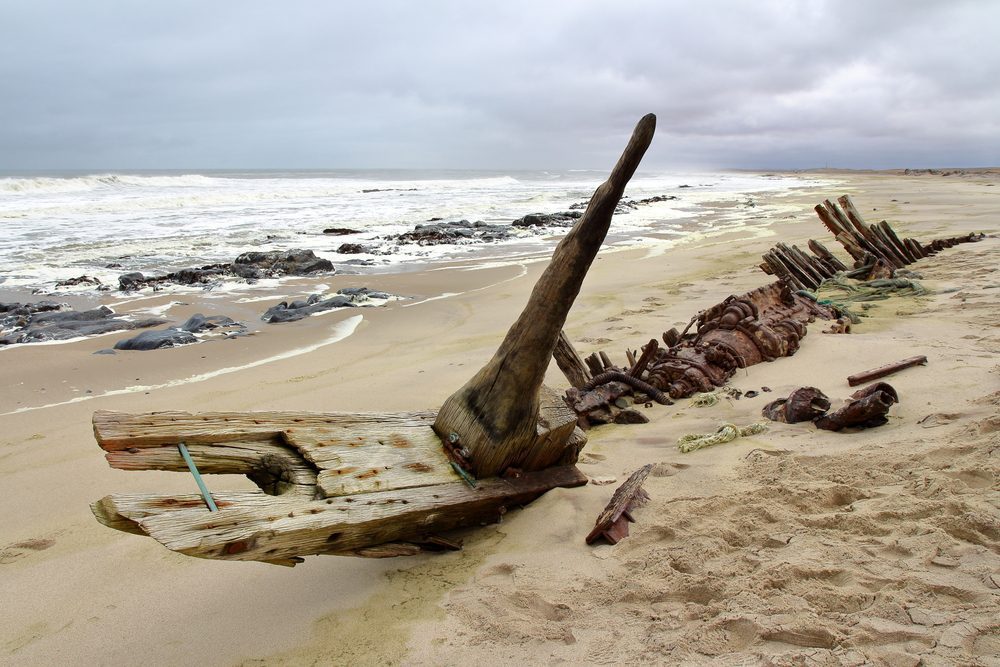
Shipwreck along Skeleton Coast. Image source: Giannimarchetti/Shutterstock.com
The Skeleton Coast Park is one of the few places in Namibia where you can experience the true wilderness.
From highest point to lowest point, this vast area of sand dunes and pounding Atlantic seas measures at least 500 kilometres.
Located where the dry deserts of the interior meet the sea, it is well known as a particularly perilous stretch of coastline.
Old tankers, skiffs, fishing boats, and convoy ships are littered everywhere as decaying monuments to this fact.
And with all the legends of shipwrecked sailors still floating about, it’s clear that the Namid elephants and hyenas have this area to themselves.
Windhoek

Aerial view of Windhoek, Namibia at sunset. Image source: Nate Hovee/Shutterstock.com
The capital city of Namibia, Windhoek, is a fascinating tiny town that serves as a miniature representation of the country as a whole.
The city was founded as a tiny pastoral community next to a bubbling freshwater spring in what is now the geographic centre of the nation.
From the palm trees of Zoo Park to the meticulously maintained gardens of Parliament Hill, the city’s interior is kept green thanks to the town’s abundant underground water supply today.
A succession of traditionally Swabian beer halls and several Bavarian-style towers that belie the ancient German influence combine to create a surprisingly lively nightlife.
Okuryangava, with its tin-shack dwellings, and Katutura, the never-ending neighbourhood, show the more difficult side of life in Namibia.
Twyfelfontein
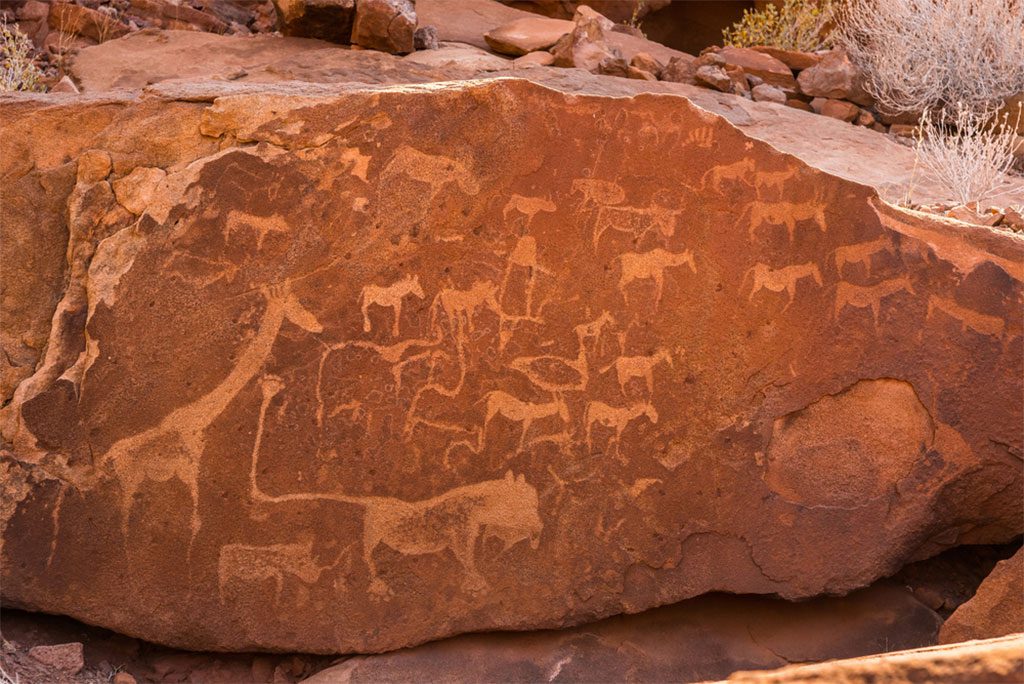
Lion Plate and bushman rock engravings at Twyfelfontein. Image source: Efimova Anna/Shutterstock.com
In truth, Twyfelfontein is not even a town. Twyfelfontein is not renowned for its rich variety of species or its bustling urban character.
In contrast, this area in the middle of the arid Kunene Region, in the very heart of northern Namibia, is famous as the site of some of Africa’s most abundant displays of ancient rock art.
As expected, UNESCO designated the area a World Heritage Site in 2007, and it is possible that people have been living there for the last six millennia.
There are more than 16 separate locations, all of which have their own unique humanoid petroglyphs.
Furthermore, the environment itself never ceases to awe; it is a mosaic of towering table mountains and undulating savannah plains.
15 Top Places to Visit in Namibia: Namib-Naukluft National Park
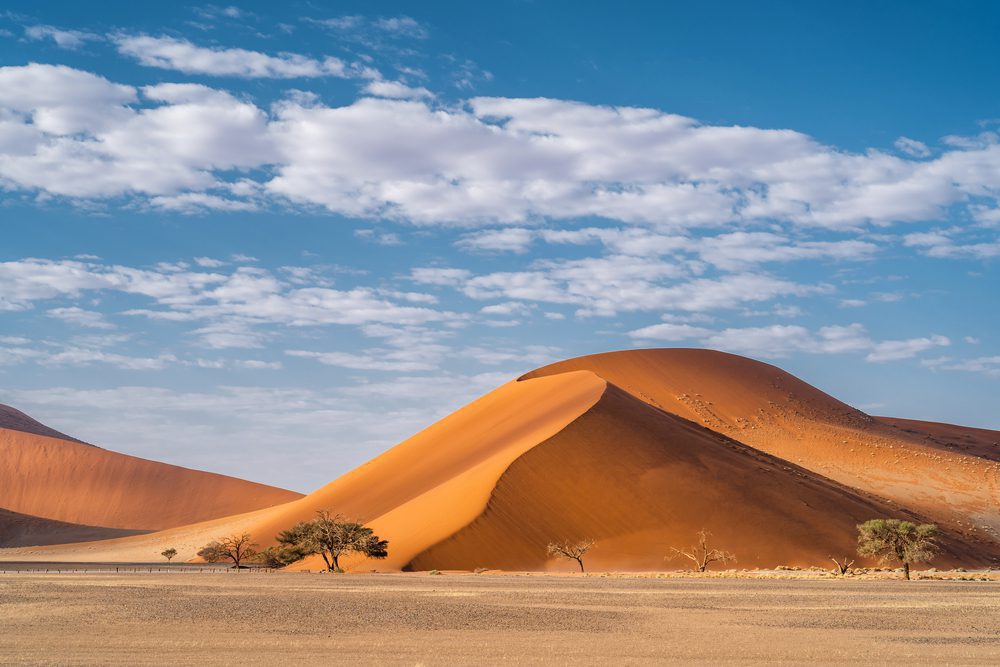
Towering sand dunes at Sossusvlei, Namibia. Image source: R.M. Nunes/Shutterstock.com
The Namib-Naukluft National Park, a seemingly unending sea of sand that contains the famous Sossusvlei sand dunes and salt flats, has already been included on our list, but it deserves a second mention due to the abundance of additional must-see attractions that can be found inside its borders.
Consider Deadvlei, a sun-baked wasteland of acacia trees (perhaps as ancient as 700 years!) and mud flats.
Closer to the coast and the city of Swakopmund, the scenery takes on a more unearthly quality, with arid plains rising to ridgebacks that evoke the maned spine of a prowling hyena.
Spitzkoppe
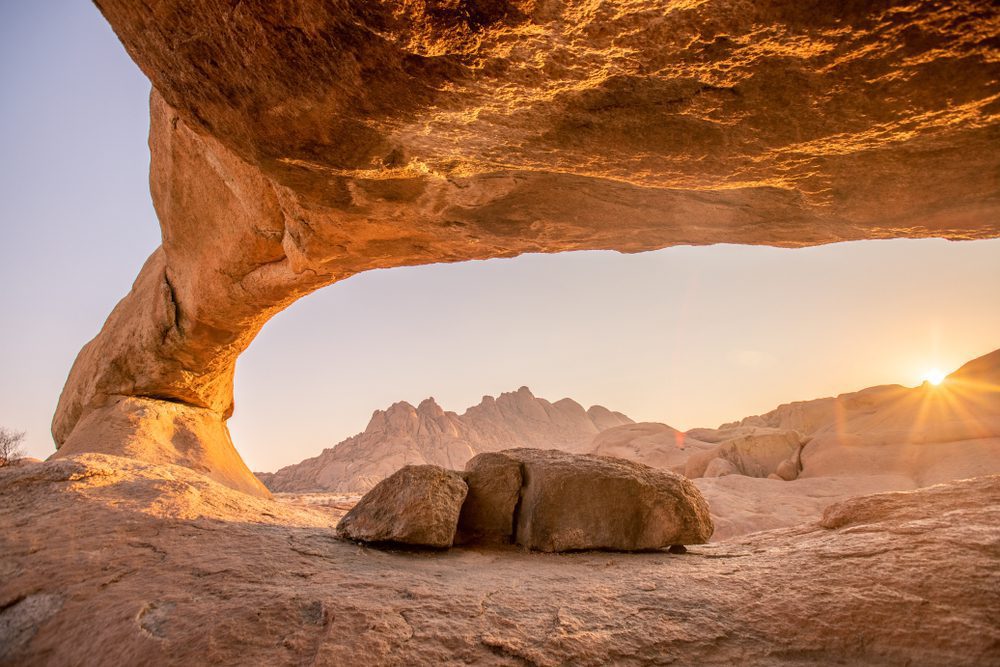
Spitzkoppe sunset in Namibia. Image source: Oriol Querol/Shutterstock.com
One of Namibia’s and the world’s most fascinating natural wonders, the Spitzkoppe, can be found in the Damaraland.
As early as the early 1900s, when initially sighted by German soldiers, similarities were made to the chiselled peaks of Switzerland’s Matterhorn.
As the twisted and distorted mass of granite stone rises more than 1,700 metres above the flat desert landscape, it is easy to understand why.
The area surrounding the mountain’s foot is teeming with ancient rock art, and there are other impressive carved rock structures, such as arches, tunnels, and bridges, to explore.
Caprivi
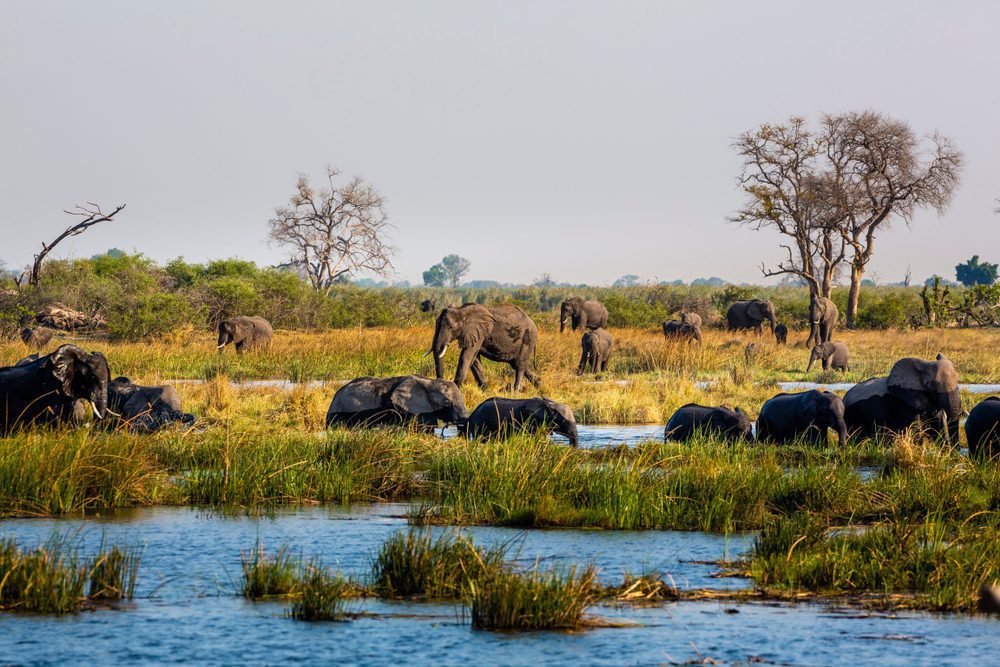
Elephants in Bwabwata, Kwando, Mudumu National Park. Image source: Radek Borovka/Shutterstock.com
The Caprivi region, often known as the Caprivi Strip, is a narrow sliver of territory that extends southward from northern Namibia and into the heart of west-central Africa.
It spans about half of Namibia and is home to ecosystems and climatic zones that can’t be found anywhere else in the nation. It also acts as a vital link for uncommon animals making the long journey interior or down to the coast, such as the Namibian elephant or the African wild dog.
The region’s distinctive flora and wildlife, including the zebras of the Mahango Game Reserve, the blue wildebeest of Bwabwata, and the green savannah of the Salambala Conservancy, are once again receiving attention after a civil conflict in the 1990s.
15 Top Places to Visit in Namibia: Kolmanskop
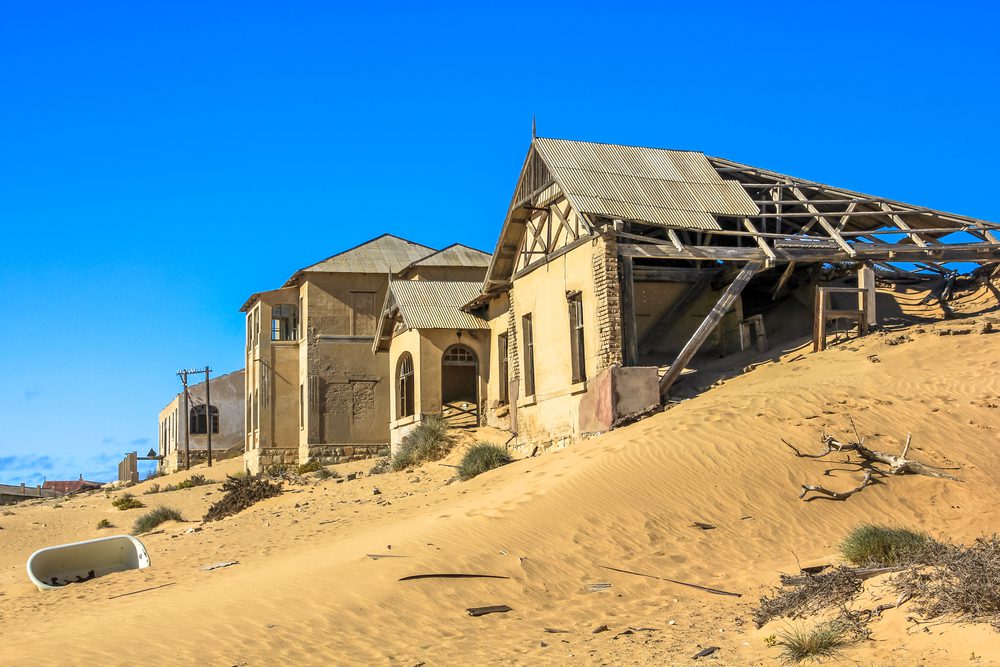
Step into the eerie ambiance of Kolmanskop, a ghost town in South Namibia, once flourishing with diamond mining activity.
Namibia’s most well-known ghost village is a spooky, unsettling place.
There has been a steady decay of the dwellings and the numerous municipal structures since the area was abandoned in the middle of the twentieth century.
This wasn’t always the case, however; in the early 1900s, Kolmanskop was supposedly one of the wealthiest cities in the nation because of a diamond boom. There was formerly a school, fire station, and ice plant in the area.
Nowadays, however, hundreds of visitors annually flock to its husk to see the long-lost way of life and take photographs of the eerie, deserted place.
12. Walvis Bay
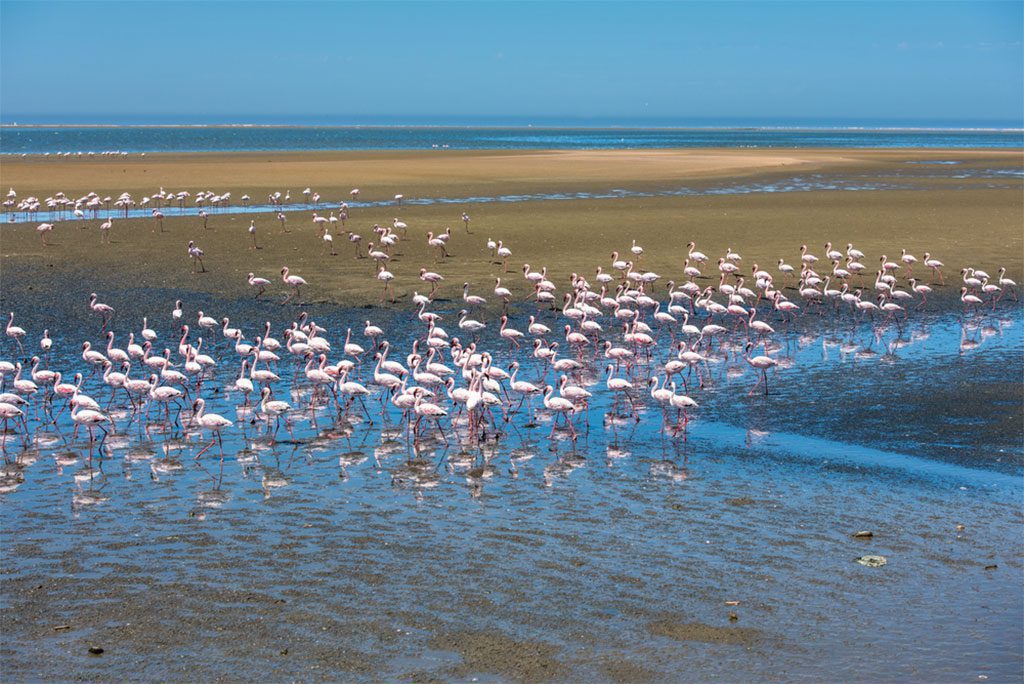
Delight in the sight of a vibrant flock of flamingos gracefully wading through the waters of Walvis Bay
Walvis Bay has been a pawn of the historical superpowers in the African theatre of war because of its strategic location on the Atlantic coast and access to one of the best deep-water ports this side of the Cape of Good Hope.
After the Portuguese and the British had left, the Germans arrived during World War I and built massive docks and supply depots.
With the colonial wars long behind it, the city has emerged as one of Namibia’s most popular tourist destinations.
There is kitesurfing off its coasts; fishing galore; trips to offshore islands teeming with birds; and sandboarding down the Namib Desert dunes.
13. Penguin Islands

Witness the adorable sight of a Magellanic penguin perched on pebbles, enjoying the coastal breeze.
Another popular destination in the area is the Walvis Bay Rocks, a collection of small islands that rise from the Atlantic Ocean not far from the shore at the site of the former German port town.
The Jackass Penguin is the national bird of the country, and its name indicates that colonies of these birds may be found there. But there’s more to see than just the flat-footed waddlers.
Exotic birds and marine life abound, and there are stunning headlands and cliffs to explore.
15 Top Places to Visit in Namibia: Fish River Canyon
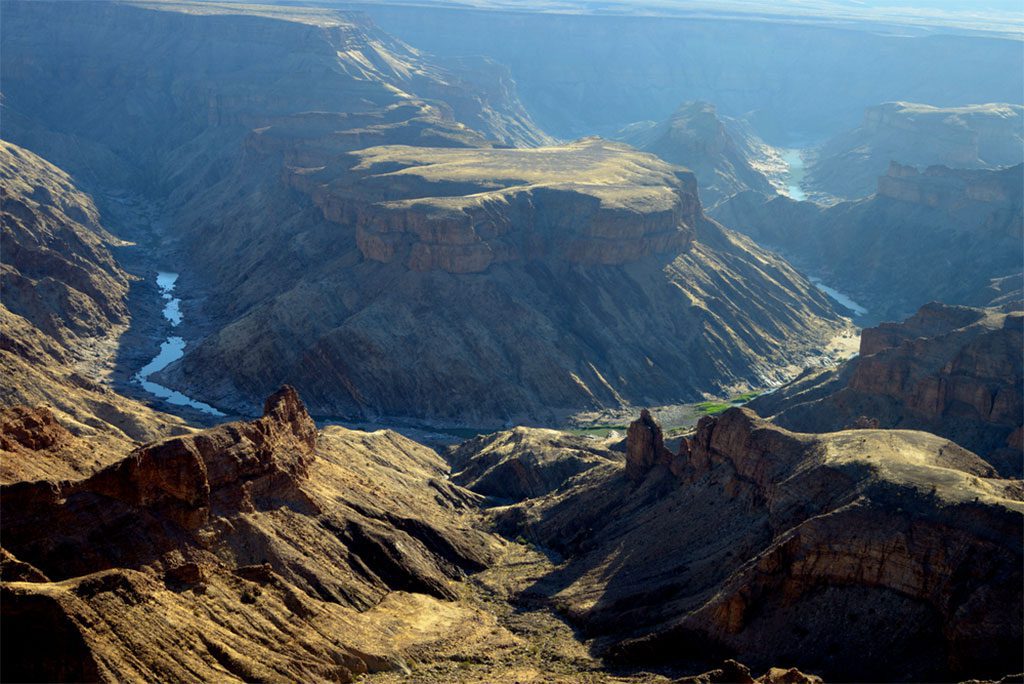
Behold the awe-inspiring vista of Fish River Canyon, a magnificent natural wonder in Namibia.
In a really spectacular form, the Fish River Canyon bends and meanders amongst the enormous mountains of southern Africa.
The valley floor is crowned by red cliffs; deep sand pits and massive boulders dot the landscape; and sunsets cast a blood-red light over the Three Sisters mountain range.
The hiking trail that spans the length of this natural marvel is an irresistible draw for adventurers.
It’s a whopping 88 kilometres long and includes tough mountain climbs and stretches of dry, arid country.
15. Hentiesbaai
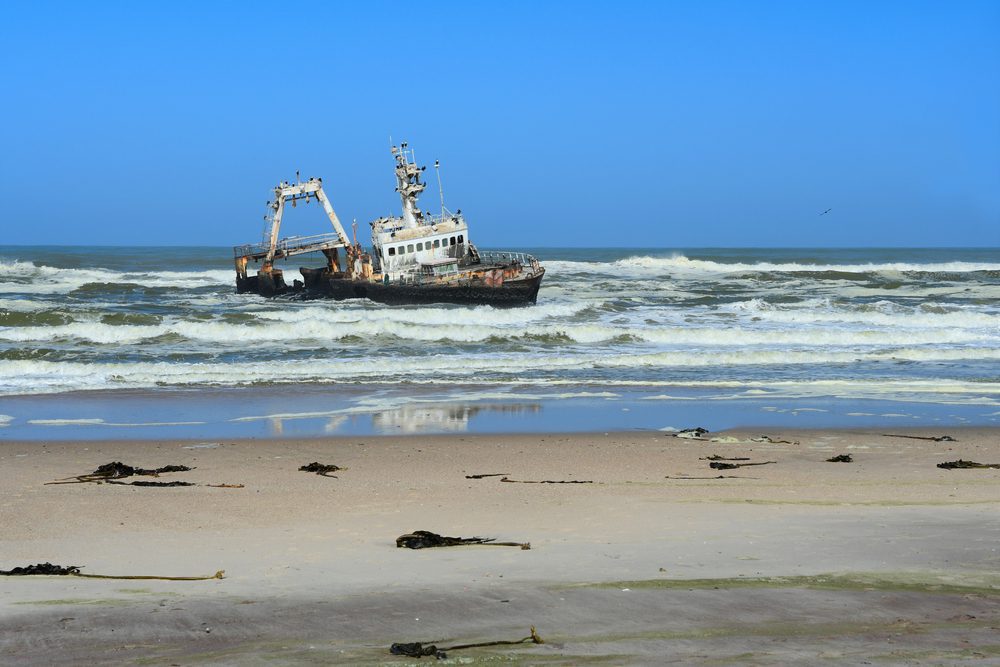
Discover the haunting beauty of Shipwreck Zeila, a testament to the unpredictable forces of the sea.
One of the most visited places in Namibia during the peak tourist season is the town of Swakopmund, which serves as the entrance to the National West Coast Recreation Area.
Many people escape the bustle of Windhoek for the stark beauty of this coastline.
Tourists go here to watch the hundreds of seals that swarm the beach banks to the north of town and to ride rumbling 4x4s through the undulating desert dunes.
Anglers and boaters frequent the area because of the abundance of marine life.
Plan your trip with ontravelx and get ready for a journey full of breathtaking sights and priceless memories.


